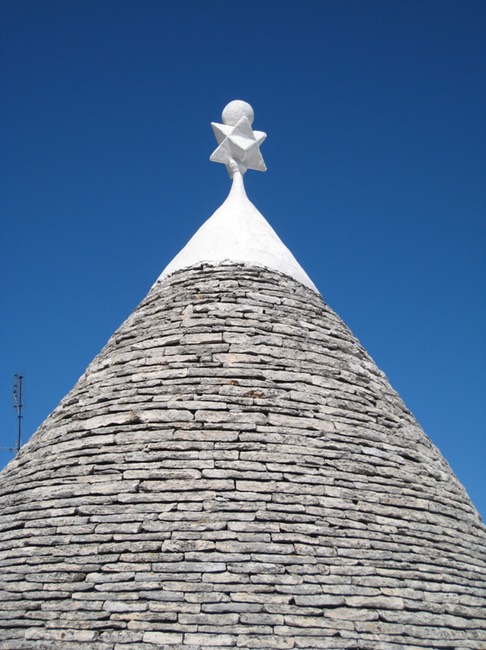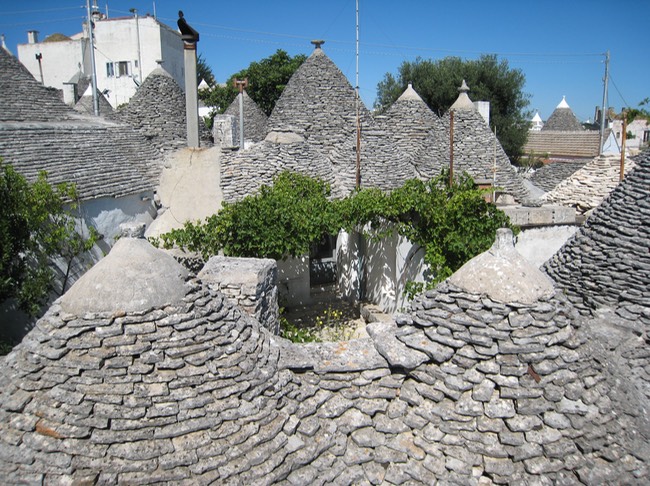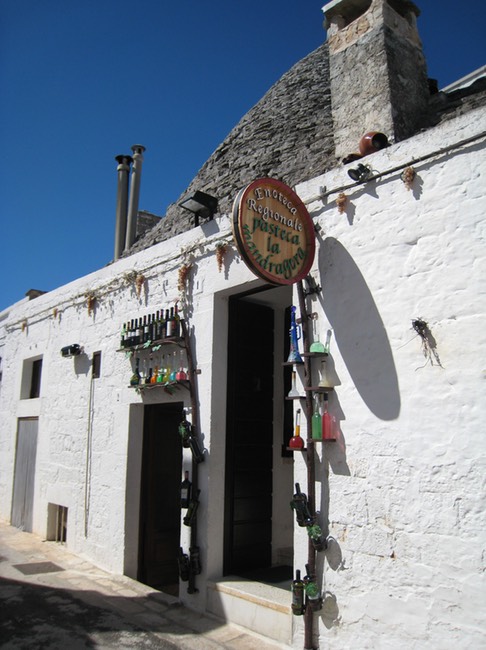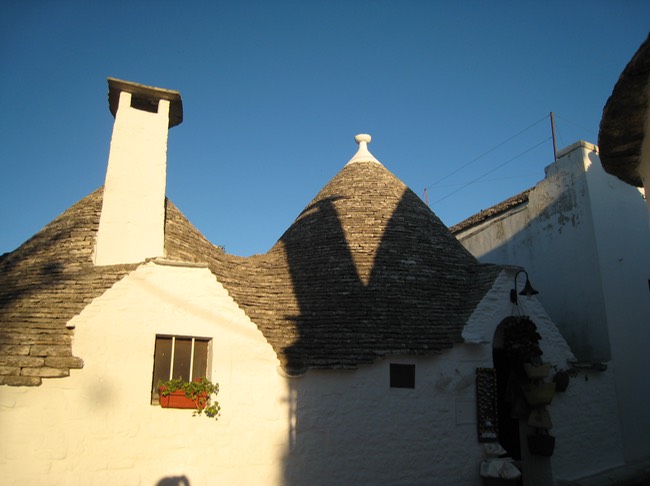Viva Italia
Interlude in Alberobello

We first saw Alberobello at the end of a long day on the autostrada, driving from Rome to Puglia, with only brief stops for Sarni pizza along the way. Partway between Bari and Brindisi, the turnoff toward Alberobello led to a lovely, winding country road, that took us away from the water, and up and up into the hills. Our rhythms adjusted very quickly to the peaceful surroundings; the car slowed and our heart rates slowed, as we wound our way through the rising farmland toward Alberobello.
We followed the main road into town, parked, and walked into the big central square. It seemed a pleasant place, typical of many mid-sized Italian towns that we had seen in the past. We found a hotel just off the piazza, a family-run place in a big, old building with a stone-tiled roof. We were checked in by the son of the family, and given a comfortable room with a little balcony. As this was the first night of our Italian stay, we felt the familiar sense of delight in the growing awareness that we were in a place so unlike home. We walked out into the piazza to look for a trattoria, and of course, a sight of the world-famous trulli.

Alberobello is known for these fascinating and mysterious buildings, with their conical, tiled roofs. We had seen photos, and had seen their rustic cousins in the south of Puglia, the caseddhi. Today, at the very beginning of a month-long visit to southern Italy, we would have our first look at the real thing. We walked across the piazza, looked down the hill, and saw, spread out below, the trulli village, a warren of grey conical roofs. Walking down the hill and crossing the busy shopping street at the bottom, we entered another world.
The narrow cobblestone streets wind up and down the hills, branching off onto short cul de sacs and long connectors. They are lined with conjoined whitewashed buildings, each with its arched doorway, potted plants, and beaded curtain. The white walls shine against the deep blue of the sky, a beautiful enough sight, even without the grey conical roofs that give a fairy-tale atmosphere to the place. The roofs are made of grey stone tiles that overlap in elaborate detail when studied closely, and merge into a smooth, symmetrical whole when looked at from afar. Each cone is topped with a distinctive symbol, representing a variety of religions.

Many of the front doors open up into shops selling souvenirs and crafts, while other houses are strung with drying laundry. One man showed us his beautifully crafted clay whistles, colourful and shaped like animals and birds, as well as some lovely tiles decorated with trulli scenes. Another man with an enoteca sold us a bottle of violetta, made by himself, and also another citrus fruit liqueur (we tasted six different drinks!) A charming elder woman was a weaver; we bought an embroidered towel from her. The wine seller spoke a little English; the other two, none at all.
None of the photos we had seen had prepared us for the amazing reality of walking between these incredible buildings, row upon row of them, along twisting roads that quickly lost us in a fantastic maze. We wandered the quiet streets, filled with both wonder at the place we found ourselves, and with pleasure at the amazing serenity that surrounded us. We ate dinner that night in a trullo restaurant, outside on a big patio with a view of the roofs. We dined on a variety of Pugliese specialties, all vegetarian and delicious, and enjoyed the coming of evening and the distant lively sounds from the modern town a short distance away.

We were fortunate to visit this amazing place just before the beginning of the tourist season, when it was relatively quiet and thus even more atmospheric. Alberobello is timeless and remarkable in much the same manner as Venice. Its charm comes from its very unusual and distinctive identity, that allows the visitor to derive pleasure simply from wandering through its quiet streets. An occasional shopkeeper comes out to chat you up, and once in a while, an automobile pushes its way around the too-sharp corners and along the too-narrow streets, but its essence is very peaceful and other-worldly. On one journey, it made a lovely and memorable welcome to Italy.
Photos: decorated roof; adjoining rooftops; shop door; rooftop geometry